Summary
At the Embedded World Show in Germany in a couple of weeks I am going to be showing a crazy demo (more on this later) that uses MBED OS and BLE and WiFi and PSoC 6 and the 4343W. Given how close things are and how new MBED OS is to me I figure that I had better get going sorting out the BLE interface. This article and probably the next several are going to show my progress through the learning curve.
It turns out that in MBED OS, instead of using the Cypress BLE Host Stack I will be using the ARM Cordio BLE host stack talking via HCI to the Cypress BLE Controller stack running on the 4343W (a Bluetooth, BLE and WiFi combo chip). At this point all of my experience with BLE has been with Cypress stacks, either the PSoC 4/6 BLE stack or with the Cypress IoT stacks e.g. the CYW20719. Lot’s of new learning. Add in that all of the code is in C++ and it makes for an adventure.
For this article I will show the steps to get an ARM BLE example going on the CY8CPROTO_062_4343W development kit. This will involve.
- Importing the ARM MBEDOS BLE Examples
- Modifying them to support the Cypress Targets & Test
- Updating an example program in a few places to fix things that I don’t like.
Import ARM MBED OS BLE Examples
The first step is to make a clone of the ARM examples by running “mbed import mbed-os-example-ble”. This will load a bunch of different example projects (as libraries)
Then, when you look at what you have after all of that mess, you can see 14 example programs with promising names.
When you look in the BLE_LED directory you will find a file “readme.md” which is a markdown formatted file. You can view this file on the GitHub website for this example here. The top of this one looks promising:
Modify and Test
I decide that the example called “BLE_LED” looks like a good place to start. This example is a simple peripheral that advertises it name. When you connect to it there is a Service with UUID “0xA000” (unfortunately a 16-bit UUID… bad demo code) that Service has one characteristic with UUID 0xA001 (another 16-UUID … that isn’t nice … come on people… haven’t you read the spec?). When you write a “1” to that characteristic the LED2 is supposed to turn on, and when you write a 0 the LED2 is supposed to turn off.
First, until the Cypress stuff is accepted into the main release, I need to update mbed-os to our targets) with “cd mbed-os ; mbed update master”. To build this project Ill run “mbed compile -t GCC_ARM -m CY8CPROTO_062_4343W”. When I program the the development kit, the LED starts blinking and I am able to see it using the GATT browser LightBlue Explorer.
But when I try to write a 1 to the 0xA001 characteristic nothing happens.
So, what gives? The answer is that on line 32 you can see that the authors as assuming that you have two LEDs (my development kit only has one.
_alive_led(LED2, 1),
_actuated_led(LED1, 0),
And on line 124 you can see a function that inverts the LED
void blink() {
_alive_led = !_alive_led;
}
which is triggered on line 47 to be called every 500ms
void start() {
_ble.gap().setEventHandler(this);
_ble.init(this, &LEDDemo::on_init_complete);
_event_queue.call_every(2000, this, &LEDDemo::blink);
_event_queue.dispatch_forever();
}
OK. I am not loving this. I think that I should make some updates to this project.
Update
There are several things that I don’t like about this program or need to be fixed.
- Make the user LED2 be LED1 and fix the fact that it is active low.
- Change the UUIDs of the Service and Characteristic to be legal 128-bit UUIDs
- Make the stdio print out the status of the connection (instead of the blinking LED1)
- Make the baud rate of standard i/o be 115200 instead of 9600
First, fix the LED2 to be LED1. Do this by commenting out all of the _alive_led code and switching the _actuated_led to be LED1. Also set the state of the LED1 to 1 (meaning off because it is active low)
//_alive_led(LED1, 1),
_actuated_led(LED1, 1),
The author of the example code has a function called blink which is executed by the event queue every 500ms, comment out that function
/*
void blink() {
_alive_led = !_alive_led;
}
*/
And don’t inject events into the queue to run the blink function
//_event_queue.call_every(500, this, &LEDDemo::blink);
The LED on my board is active low… so instead of writing the value write the opposite of the value.
_actuated_led = !*(params->data);
It is illegal in Bluetooth to use 16-bit UUIDs without first registering them with the Bluetooth SIG and having them be “Assigned numbers”. The author of this example program violated the specification by assigning the LED service UUID of 0xA000 and the LED characteristic UUID of 0xA001. This is super annoying and I am not willing to be a slob. To fix this modify ledservice.h to declare the UUIDs as UUID type instead of uint16_ts
//const static uint16_t LED_SERVICE_UUID = 0xA000;
//const static uint16_t LED_STATE_CHARACTERISTIC_UUID = 0xA001;
const static UUID LED_SERVICE_UUID;
const static UUID LED_STATE_CHARACTERISTIC_UUID;
Then initialize them in the main.cpp as 128-bit UUIDs using the const char * initializer.
const UUID LEDService::LED_SERVICE_UUID("21c04d09-c884-4af1-96a9-52e4e4ba195b");
const UUID LEDService::LED_STATE_CHARACTERISTIC_UUID("1e500043-6b31-4a3d-b91e-025f92ca9763");
The original code has a blinking LED. Which I dont really like. Typically, I like to blink the LED when the device is advertising, and make it be solid when there is a connection. However, as I only have one LED on my board, and I have allocated it to be the “_actuated_led”, I will use the UART to print out status changes. To do this, I update the “onDisconnectionComplete” and “onConnectionComplete” events to print out that fact to stdio.
void onDisconnectionComplete(const ble::DisconnectionCompleteEvent&) {
_ble.gap().startAdvertising(ble::LEGACY_ADVERTISING_HANDLE);
printf("DisconnectionCompleteEvent\n");
}
void onConnectionComplete ( const ble::ConnectionCompleteEvent & event )
{
printf("onConnectionComplete\n");
}
In order to set the stdio to use 115200 instead of 9600 you can change the default rate of the UART in the mbed_app.json.
"CY8CPROTO_062_4343W": {
"platform.stdio-baud-rate": 115200,
"platform.default-serial-baud-rate": 115200
},
Here is the final version of main.cpp
/* mbed Microcontroller Library
* Copyright (c) 2006-2013 ARM Limited
*
* Licensed under the Apache License, Version 2.0 (the "License");
* you may not use this file except in compliance with the License.
* You may obtain a copy of the License at
*
* http://www.apache.org/licenses/LICENSE-2.0
*
* Unless required by applicable law or agreed to in writing, software
* distributed under the License is distributed on an "AS IS" BASIS,
* WITHOUT WARRANTIES OR CONDITIONS OF ANY KIND, either express or implied.
* See the License for the specific language governing permissions and
* limitations under the License.
*/
#include <events/mbed_events.h>
#include <mbed.h>
#include "ble/BLE.h"
#include "LEDService.h"
#include "pretty_printer.h"
const static char DEVICE_NAME[] = "LED";
static EventQueue event_queue(/* event count */ 10 * EVENTS_EVENT_SIZE);
//const UUID::LongUUIDBytes_t testbytes = { 0x21, 0xc0, 0x4d, 0x09, 0xc8, 0x84, 0x4a, 0xf1, 0x96, 0xa9, 0x52, 0xe4, 0xe4, 0xba, 0x19, 0x5b } ;
// {0x1e, 0x50, 0x00, 0x43, 0x6b, 0x31, 0x4a, 0x3d, 0xb9, 0x1e, 0x02, 0x5f, 0x92, 0xca, 0x97, 0x63}
//const UUID LEDService::LED_SERVICE_UUID(testbytes,UUID::MSB);
const UUID LEDService::LED_SERVICE_UUID("21c04d09-c884-4af1-96a9-52e4e4ba195b");
const UUID LEDService::LED_STATE_CHARACTERISTIC_UUID("1e500043-6b31-4a3d-b91e-025f92ca9763");
class LEDDemo : ble::Gap::EventHandler {
public:
LEDDemo(BLE &ble, events::EventQueue &event_queue) :
_ble(ble),
_event_queue(event_queue),
//_alive_led(LED1, 1),
_actuated_led(LED1, 1),
_led_uuid(LEDService::LED_SERVICE_UUID),
_led_service(NULL),
_adv_data_builder(_adv_buffer) { }
~LEDDemo() {
delete _led_service;
}
void start() {
_ble.gap().setEventHandler(this);
_ble.init(this, &LEDDemo::on_init_complete);
//_event_queue.call_every(500, this, &LEDDemo::blink);
_event_queue.dispatch_forever();
}
private:
/** Callback triggered when the ble initialization process has finished */
void on_init_complete(BLE::InitializationCompleteCallbackContext *params) {
if (params->error != BLE_ERROR_NONE) {
printf("Ble initialization failed.");
return;
}
_led_service = new LEDService(_ble, false);
_ble.gattServer().onDataWritten(this, &LEDDemo::on_data_written);
print_mac_address();
start_advertising();
}
void start_advertising() {
/* Create advertising parameters and payload */
ble::AdvertisingParameters adv_parameters(
ble::advertising_type_t::CONNECTABLE_UNDIRECTED,
ble::adv_interval_t(ble::millisecond_t(1000))
);
_adv_data_builder.setFlags();
_adv_data_builder.setLocalServiceList(mbed::make_Span(&_led_uuid, 1));
_adv_data_builder.setName(DEVICE_NAME);
/* Setup advertising */
ble_error_t error = _ble.gap().setAdvertisingParameters(
ble::LEGACY_ADVERTISING_HANDLE,
adv_parameters
);
if (error) {
printf("_ble.gap().setAdvertisingParameters() failed\r\n");
return;
}
error = _ble.gap().setAdvertisingPayload(
ble::LEGACY_ADVERTISING_HANDLE,
_adv_data_builder.getAdvertisingData()
);
if (error) {
printf("_ble.gap().setAdvertisingPayload() failed\r\n");
return;
}
/* Start advertising */
error = _ble.gap().startAdvertising(ble::LEGACY_ADVERTISING_HANDLE);
if (error) {
printf("_ble.gap().startAdvertising() failed\r\n");
return;
}
}
/**
* This callback allows the LEDService to receive updates to the ledState Characteristic.
*
* @param[in] params Information about the characterisitc being updated.
*/
void on_data_written(const GattWriteCallbackParams *params) {
if ((params->handle == _led_service->getValueHandle()) && (params->len == 1)) {
_actuated_led = !*(params->data);
}
}
/*
void blink() {
_alive_led = !_alive_led;
}
*/
private:
/* Event handler */
void onDisconnectionComplete(const ble::DisconnectionCompleteEvent&) {
_ble.gap().startAdvertising(ble::LEGACY_ADVERTISING_HANDLE);
printf("DisconnectionCompleteEvent\n");
}
void onConnectionComplete ( const ble::ConnectionCompleteEvent & event )
{
printf("onConnectionComplete\n");
}
private:
BLE &_ble;
events::EventQueue &_event_queue;
//DigitalOut _alive_led;
DigitalOut _actuated_led;
UUID _led_uuid;
LEDService *_led_service;
uint8_t _adv_buffer[ble::LEGACY_ADVERTISING_MAX_SIZE];
ble::AdvertisingDataBuilder _adv_data_builder;
};
/** Schedule processing of events from the BLE middleware in the event queue. */
void schedule_ble_events(BLE::OnEventsToProcessCallbackContext *context) {
event_queue.call(Callback<void()>(&context->ble, &BLE::processEvents));
}
int main()
{
printf("Example Bluetooth\n");
BLE &ble = BLE::Instance();
ble.onEventsToProcess(schedule_ble_events);
LEDDemo demo(ble, event_queue);
demo.start();
return 0;
}
And LEDService.h
/* mbed Microcontroller Library
* Copyright (c) 2006-2013 ARM Limited
*
* Licensed under the Apache License, Version 2.0 (the "License");
* you may not use this file except in compliance with the License.
* You may obtain a copy of the License at
*
* http://www.apache.org/licenses/LICENSE-2.0
*
* Unless required by applicable law or agreed to in writing, software
* distributed under the License is distributed on an "AS IS" BASIS,
* WITHOUT WARRANTIES OR CONDITIONS OF ANY KIND, either express or implied.
* See the License for the specific language governing permissions and
* limitations under the License.
*/
#ifndef __BLE_LED_SERVICE_H__
#define __BLE_LED_SERVICE_H__
class LEDService {
public:
//const static uint16_t LED_SERVICE_UUID = 0xA000;
//const static uint16_t LED_STATE_CHARACTERISTIC_UUID = 0xA001;
const static UUID LED_SERVICE_UUID;
const static UUID LED_STATE_CHARACTERISTIC_UUID;
LEDService(BLEDevice &_ble, bool initialValueForLEDCharacteristic) :
ble(_ble), ledState(LED_STATE_CHARACTERISTIC_UUID, &initialValueForLEDCharacteristic)
{
GattCharacteristic *charTable[] = {&ledState};
GattService ledService(LED_SERVICE_UUID, charTable, sizeof(charTable) / sizeof(GattCharacteristic *));
ble.gattServer().addService(ledService);
}
GattAttribute::Handle_t getValueHandle() const
{
return ledState.getValueHandle();
}
private:
BLEDevice &ble;
ReadWriteGattCharacteristic<bool> ledState;
};
#endif /* #ifndef __BLE_LED_SERVICE_H__ */
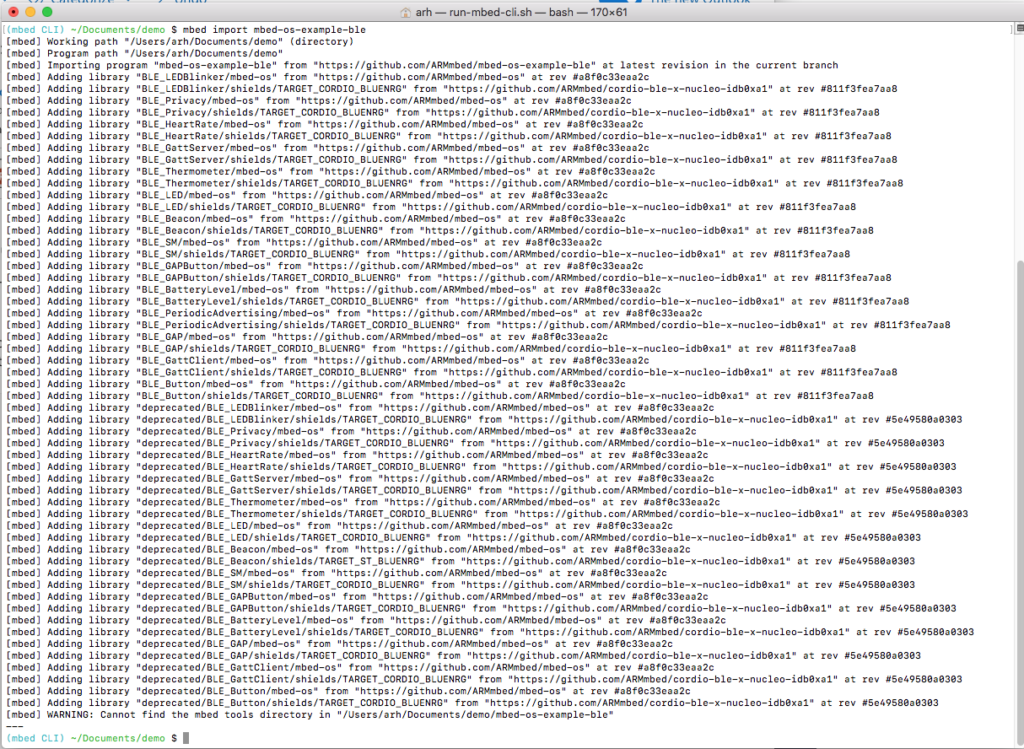


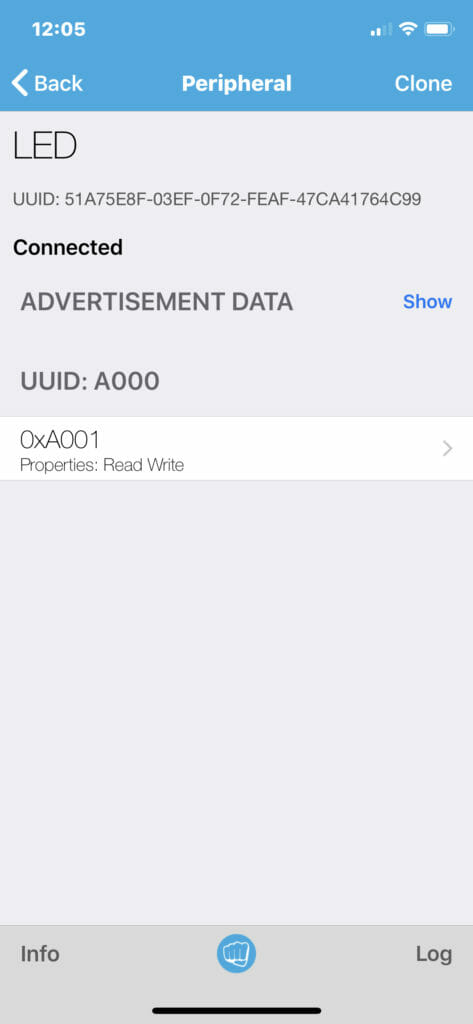
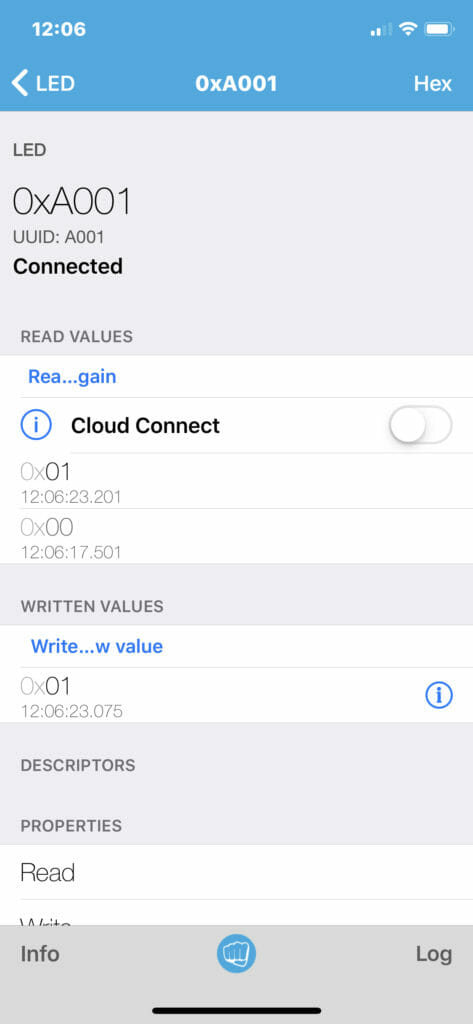
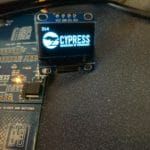


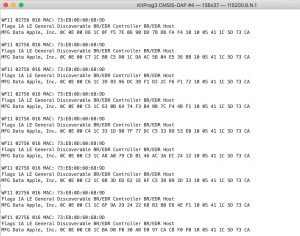
1 Comment
Hey Alan!
I just got my WiFi-BT Combo Prototyping Board and I’m so pumped up to try new things on it!
I’ve seen that the examples that mbed-os provides as a initial step for WiFi connectivity doesn’t support Cypress Boards yet (at least that’s what their documentation says). And I’ve also seen that the examples that you provide in your section of the mbed site is dedicated to some kind of MQTT communication tied to AWS.
Do you know where I can find some simple examples in order to get familiar with the Network API among others using your boards?
Thanks in advance and I’m looking forward to contribute for this community!